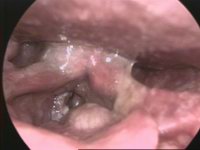
Photo from wikipedia
Objective To analyse the surgical indications, surgical efficacy and key influencing factors of prognosis of using a novel surgical approach for pyriform sinus carcinoma resection utilising the paraglottic space. Methods… Click to show full abstract
Objective To analyse the surgical indications, surgical efficacy and key influencing factors of prognosis of using a novel surgical approach for pyriform sinus carcinoma resection utilising the paraglottic space. Methods From 2014 to 2017, 93 patients with squamous cell carcinoma originating in the pyriform sinus were resected through the paraglottic space approach. The postoperative laryngeal function preservation, complications, survival rate and prognostic factors were analysed. Results All patients were followed up for more than 5 years. The 2, 3 and 5 year overall survival rates of the patients were 77.2%, 61.6% and 47.4%, respectively. The univariate analysis of survival rate showed that primary tumour T stage and N stage had a statistically significant effect on the survival rate of patients (P = 0.047 and P < 0.001, respectively). Multivariate analysis with the Cox regression model revealed that N stage is an independent risk factor for postoperative survival (P = 0.042). The preservation rate of laryngeal function was 65.6% (61/93). Pharyngeal fistula incidence was 4.3% (4/93). Systemic distant metastasis and second primary cancer were found to be the main causes of death. Conclusions As a novel surgical approach for the resection of pyriform sinus carcinoma, the paraglottic space approach can better expose the tumour, effectively improve the retention rate of laryngeal function, reduce the incidence of pharyngeal fistula and result in the better recovery of postoperative swallowing function with satisfactory long-term survival. N stage is an independent risk factor for postoperative survival.
Journal Title: Frontiers in Surgery
Year Published: 2023
Link to full text (if available)
Share on Social Media: Sign Up to like & get
recommendations!